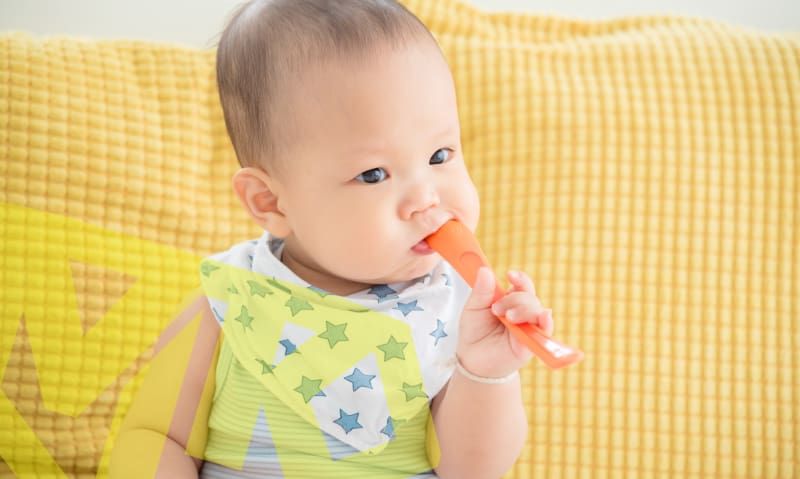A New Parent’s Guide to Excellent Infant Dental Care

Make your baby’s dental health a priority.
When your baby is a newborn, your days are filled with around-the-clock care. As you learn to navigate their eating and sleeping schedule, you’re also discovering many other “firsts” about your little one. You know which toys they love, which baby foods they detest, and what each new grin means.
Have you considered how you’ll take care of their teeth and gums from the very beginning? While their first baby tooth might seem light-years away, infant dental care is an important first step toward a lifetime of healthy habits. Today, we’re sharing a few easy steps you can take to make sure their oral hygiene is off to a great start, starting on day one.
Clean their gums.
You won’t have any baby teeth to clean for a while. In fact, most babies don’t cut their first tooth until around six months to one year of age. Still, it’s important to clean around their mouth after each feeding, even if that simply means massaging and cleansing their gums for now. Use a clean, moist washcloth or piece of gauze to wipe their gums clean and remove any stuck-on debris.
Avoid juice in bottles.
If you use a bottle to feed your baby, remember to only fill it with milk, breast milk, plain water, or formula. Filling it with fruit juice or sweetened water can lead to tooth decay, even if there aren’t any teeth erupted just yet!
At the same time, make sure to always take the bottle from your baby before laying them down to sleep. Even if it’s filled with milk or water, allowing them to fall asleep with liquid on their gums could lead to decay.
Brush their first tooth.
It might be the tiniest pearly white you’ve ever seen, but you’ll still need to brush your baby’s very first tooth! In the very beginning, you can use an infant toothbrush with soft bristles to clean around the tooth. You won’t use any toothpaste just yet, but as they get a little bigger and more teeth emerge, you can add a small amount of fluoride toothpaste. Start super small, with a dot about the size of a grain of rice!
Relieve teething symptoms.
Is your baby teething? While most children don’t experience a significant amount of pain at this milestone, it can be a little uncomfortable. You might find that your infant is fussier than normal or is drooling all over the place!
To help relieve their symptoms, you can gently massage their teeth and gums with a cold, clean washcloth. You can also use standard teething rings you find in the store, allowing them to gnaw on the surface to relieve the pressure in their gums. If you go this route, look for solid teething rings rather than liquid-filled ones. Using clean hands, you can also give them a tiny, hands-on gum massage!
Whichever method you try, avoid reaching for alternative or homeopathic treatments to relieve your baby’s teething pain. These include teething tablets, gels that contain benzocaine, and amber teething necklaces, among others. The effectiveness of these treatments has not been verified, and the FDA has actually issued warnings against benzocaine.
Schedule a dentist appointment.
As soon as you can, it’s smart to find a pediatric dental home for your child. This is one of the most important steps you can take in their long-term dental care. Ideally, your baby’s first dental appointment should take place before their first birthday or within six months after their first tooth erupts.
This first visit is a great time for your child to meet the dental team and tour the office. If you visit our practice, we’ll use this time to gather important information on your child’s dental and medical health, share advice on healthy habits, and if they’re comfortable, we’ll also perform a comprehensive dental examination.
Start flossing early.
As soon as your child’s first teeth begin to touch, you can teach them all about the importance of flossing! Today, there are special flossing tools specially designed to fit even the tiniest hands to make this process fun and enjoyable. Of course, getting your little ones into this habit is a lot easier if you’re already an avid flosser yourself, so remember to keep your habits up too!
Transition to a sippy cup.
When your child is around six to nine months old, they should be able to transition from a bottle to a sippy cup. The sippy cup can have a hard, attached spout or a detachable straw.
Either way, this transition is an important one. Sippy cups help prevent liquid from pooling around your child’s teeth and can help keep them cleaner as they eat and drink.
Help them brush.
Even when your child is big enough to maneuver a toothbrush on their own, they’ll still need your help and supervision in the bathroom. Continue to monitor and supervise them, making sure they’re brushing every surface of their teeth. This should continue until around the age of six. At that point, your child should have mastered the art of rinsing and spitting without assistance!
Learn more about infant dental care.
Effective infant dental care starts at home. Even when your baby is only a few days old, you can start taking care of their teeth and gums. As you do, you can set a firm foundation for lifelong habits they’ll thank you for down the road. From gently cleaning their tiny gums to helping them floss, rinse, and spit, there are plenty of steps to learn and follow together. Along the way, our team is here to help. Contact us to learn more about our approach to pediatric dentistry or schedule an appointment today!